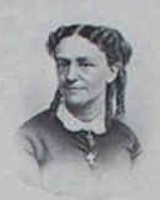
Phebe Ann Coffin Hanaford
Biography
Phebe Ann Coffin Hanaford may be America's earliest certifiable lesbian minister. According to Lisa M. Tetrault (see below), Phebe Ann (Coffin) Hanaford was born in Siasconset on Nantucket Island on May 6, 1829, the only child of the merchant and shipowner George W. Coffin and his wife Phebe Ann (Barnard) Coffin. Both were Quakers and direct descendants of the island's first white settlers, Tristram Coffin and Peter Folger.
Beginning in 1857, Phebe began to live in other towns on mainland Massachusetts, with her husband Dr. Joseph Hanaford. During the 1850s and 1860s, as Phebe raised her children, she became a highly successful author, and later gave her first sermons, having joined the Unitarian ministry. While visiting Nantucket in 1865, she accepted her father's invitation to give her first sermon. A year later, she was "surprised and honored," says Tetrault, when asked to substitute in South Canton, New York, for the Rev. Olympia Brown, the first ordained Universalist woman minister. "I dared not refuse to go," she said, according to Tetrault: "it seemed to be the Lord's call. [So] I went." Phebe separated from her husband and accepted a position with the First Universalist Church of New Haven, Connecticut, in 1870, at an annual salary of $2,000. That same year, adds Tetrault, she served as chaplain for the Connecticut Legislature.
At the time she first took the pulpit, Hanaford was also becoming an important leader in the women's rights movement. Together with other leaders of a feminist-abolitionist coalition, such as Lucy Stone, Julia Ward Howe, Thomas Wentworth Higginson, and William Lloyd Garrison, she helped establish the American Woman Suffrage Organization (1869). In the following decade, when Hanaford accepted a position with the Universalist Church of the Good Shepherd in Jersey City, New Jersey, the congregation split, ostensibly over her women's rights activities. Legend has it that her political activism alienated her congregation. She refused a demand to abandon politics, and in 1877, reports Tetrault, a majority of voting members failed to reappoint her. Hanaford then formed a second Universalist society at a rented auditorium and preached there for the next several years.
"Hanaford's letters and papers, however, offer a somewhat different explanation for the split," says Lisa Tetrault. "Hanaford had begun living with a woman named Ellen Miles. Newspaper clippings preserved in Hanaford's scrapbook reported that the disgruntlement among congregation members was, in fact, over Hanaford's liaison with Miles, whom the papers called the 'minister's wife.' Hanaford, it seems, was not simply asked to cease her women's rights activities, but more specifically, to 'dismiss' Miss Miles... their letters testify to a deep and abiding affection. The two remained life-long companions, separated after forty-four years together only by Miles's death in 1914."
Reference: "A Paper Trail: Piecing Together the Life of Phebe Hanaford," by Lisa M. Tetrault.
http://www.nha.org/history/hn/HNhanaford.htm
(Biographical statemnet written by Mitchell Santine Gould, www.leavesofgrass.org.)
Biography Date: February, 2004
Tags
Unitarian Universalist | Ordination/clergy | Women and Religion | Massachusetts
Citation
“Phebe Ann Coffin Hanaford | Profile”, LGBTQ Religious Archives Network, accessed April 16, 2024, https://lgbtqreligiousarchives.org/profiles/phebe-ann-coffin-hanaford.
Remembrances
Know Phebe Ann Coffin Hanaford? Tell us your experience.
(All entries are reviewed by the LGBT-RAN office before posting.)